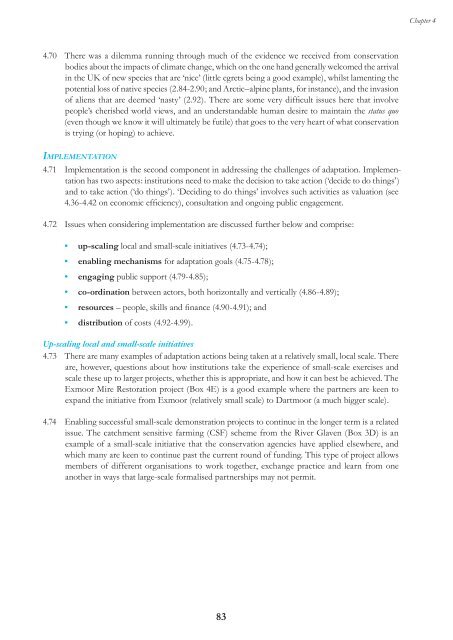Twenty-eighth Report Adapting Institutions to Climate Change Cm ...
Twenty-eighth Report Adapting Institutions to Climate Change Cm ...
Twenty-eighth Report Adapting Institutions to Climate Change Cm ...
You also want an ePaper? Increase the reach of your titles
YUMPU automatically turns print PDFs into web optimized ePapers that Google loves.
4.70<br />
There was a dilemma running through much of the evidence we received from conservation<br />
bodies about the impacts of climate change, which on the one hand generally welcomed the arrival<br />
in the UK of new species that are ‘nice’ (little egrets being a good example), whilst lamenting the<br />
potential loss of native species (2.84-2.90; and Arctic–alpine plants, for instance), and the invasion<br />
of aliens that are deemed ‘nasty’ (2.92). There are some very difficult issues here that involve<br />
people’s cherished world views, and an understandable human desire <strong>to</strong> maintain the status quo<br />
(even though we know it will ultimately be futile) that goes <strong>to</strong> the very heart of what conservation<br />
is trying (or hoping) <strong>to</strong> achieve.<br />
IMPLEMENTATION<br />
4.71 Implementation is the second component in addressing the challenges of adaptation. Implementation<br />
has two aspects: institutions need <strong>to</strong> make the decision <strong>to</strong> take action (‘decide <strong>to</strong> do things’)<br />
and <strong>to</strong> take action (‘do things’). ‘Deciding <strong>to</strong> do things’ involves such activities as valuation (see<br />
4.36-4.42 on economic efficiency), consultation and ongoing public engagement.<br />
4.72<br />
Issues when considering implementation are discussed further below and comprise:<br />
up-scaling local and small-scale initiatives (4.73-4.74);<br />
enabling mechanisms for adaptation goals (4.75-4.78);<br />
engaging public support (4.79-4.85);<br />
co-ordination between ac<strong>to</strong>rs, both horizontally and vertically (4.86-4.89);<br />
resources – people, skills and finance (4.90-4.91); and<br />
distribution of costs (4.92-4.99).<br />
Up-scaling local and small-scale initiatives<br />
4.73 There are many examples of adaptation actions being taken at a relatively small, local scale. There<br />
are, however, questions about how institutions take the experience of small-scale exercises and<br />
scale these up <strong>to</strong> larger projects, whether this is appropriate, and how it can best be achieved. The<br />
Exmoor Mire Res<strong>to</strong>ration project (Box 4E) is a good example where the partners are keen <strong>to</strong><br />
expand the initiative from Exmoor (relatively small scale) <strong>to</strong> Dartmoor (a much bigger scale).<br />
4.74<br />
Enabling successful small-scale demonstration projects <strong>to</strong> continue in the longer term is a related<br />
issue. The catchment sensitive farming (CSF) scheme from the River Glaven (Box 3D) is an<br />
example of a small-scale initiative that the conservation agencies have applied elsewhere, and<br />
which many are keen <strong>to</strong> continue past the current round of funding. This type of project allows<br />
members of different organisations <strong>to</strong> work <strong>to</strong>gether, exchange practice and learn from one<br />
another in ways that large-scale formalised partnerships may not permit.<br />
83<br />
Chapter 4
















